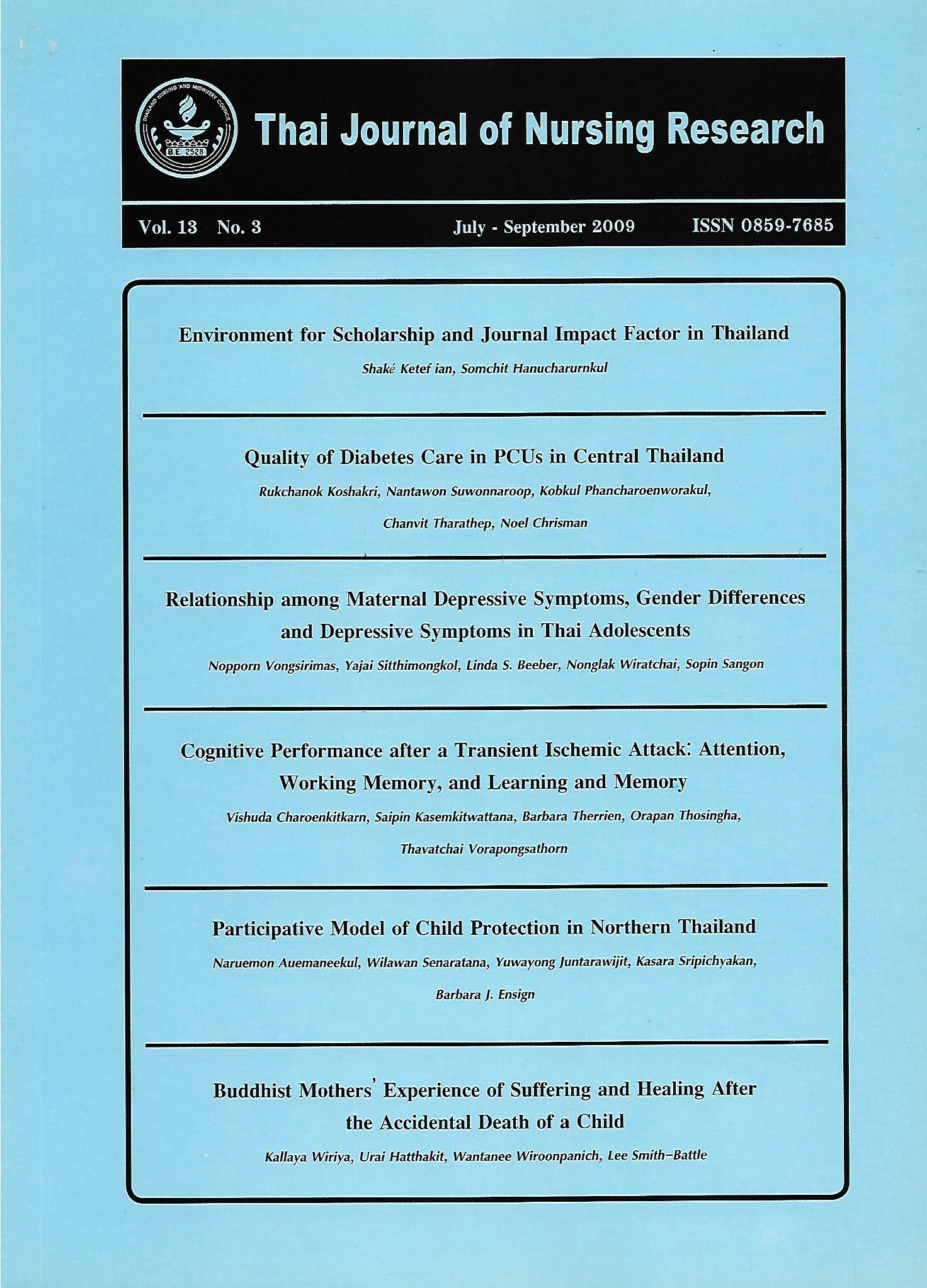Buddhist Mothers’ Experience of Suffering and Healing After the Accidental Death of a Child
Keywords:
การเสียชีวิตของบุตร, ศาสนาพุทธ, ความทุกข์, การเยียวยา, ปรากฏการณ์วิทยาแบบกาดาเมอร์เรียนเฮอร์เมนนิวติก, death of child, buddhism, suffering, healing, Gadamerian hermeneutic phenomenologyAbstract
บทคัดย่อ
มีการศึกษาทางการพยาบาลมากมาย แต่ไม่มีการศึกษาเกี่ยวกับประสบการณ์ความทุกข์และการเยียวยาของมารดาไทยพุทธหลังจากการเสียชีวิตของบุตรเนื่องจากอุบัติเหตุ การศึกษาครั้งนี้มีวัตถุประสงค์เพื่อเข้าใจความหมายเชิงลึกของปรากฏการณ์ความทุกข์และการเยียวยาของมารดาไทยพุทธที่สูญเสียบุตรเนื่องจากอุบัติเหตุโดยใช้หลักปรัชญาทางพุทธศาสนา และวิธีการวิจัยเชิงปรากฏการณ์ วิทยาแบบเฮอร์เมนนิวติกตามหลักปรัชญาของกาดาเมอร์
มารดาผู้สูญเสียบุตรเนื่องจากอุบัติเหตุ10 ราย ซึ่งถูกเลือกจากโรงพยาบาลของรัฐ ในจังหวัดสงขลา รวบรวมข้อมูลโดยการสัมภาษณ์เจาะลึกและวิเคราะห์ข้อมูลเชิงคุณภาพโดยใช้วิธีวิจัยปรากฏการณ์ วิทยาเฮอร์เมนนิวติก พบว่า การให้ความหมาย ความทุกข์ ของมารดาไทยพุทธที่สูญเสียบุตรเนื่องจาก อุบัติเหตุมี 5 ความหมาย ดังนี้: หัวใจของแม่แตกสลายเป็นเสี่ยงๆ; ร่างกายที่ไร้ความรู้สึกและหมดพลังในการต่อสู้ชีวิต; ความสุขในชีวิตขาดหายไป; ความโกรธและความแค้นทั้งต่อตนเองและบุคคลที่เกี่ยวข้อง กับการตายของบุตร และ ความเป็นห่วงและกังวลเกี่ยวกับชีวิตใหม่หลังความตายของบุตร มารดาไทยพุทธที่สูญเสียบุตรเนื่องจากอุบัติเหตุสะท้อนประสบการณ์การเยียวยาจากความทุกข์ 5 ประเด็นดังนี้: การปรับเปลี่ยนความสัมพันธ์กับบุตรที่เสียชีวิต; การยกย่องเชิดชูบุตรที่เสียชีวิตเป็นคนดีสามารถไปสู่สรวงสวรรค์; การทำบุญเพื่อส่งผลบุญไปให้บุตรคนที่เสียชีวิต; การเยียวยาตนเองโดยการทำความเข้าใจตนเองและการพัฒนาจิต และการเสาะหาแหล่งสนับสนุนอื่นๆ
ผลการศึกษามีความสำคัญต่อพยาบาล และเจ้าหน้าที่ทางด้านสุขภาพ เพื่อนำไปประยุกต์ใช้ในการดูแลมารดาไทยพุทธที่สูญเสียบุตรเนื่องจากอุบัติเหตุต่อไป
คำสำคัญ: การเสียชีวิตของบุตร ศาสนาพุทธ ความทุกข์ การเยียวยา ปรากฏการณ์วิทยาแบบกาดาเมอร์เรียนเฮอร์เมนนิวติก
Abstract
Numerous nursing studies have examined suffering, but none have addressed the suffering and healing Buddhist mothers experience after the accidental death of a child. The purpose of this study was to gain understanding of the meaning of suffering and the practices of healing and suffering, among Buddhist mothers after such a loss. Buddhist concepts provided the philosophical framework, and Gadamerian hermeneutic phenomenology provided the methodological framework, for this investigation.
Ten Buddhist mothers were recruited from a government hospital in Songkhla province, Thailand. In-depth interviews were conducted and data were analyzed using hermeneutics. Five themes that reflected the meaning of suffering among Buddhist mothers, after the accidental death of a child, were identified. They included: the mother’s heart was torn into pieces; the mother’s body was frozen and she was uncertain she would survive; happiness in the mother’s life was missing; the mother’s anger and rage at self and others; and, the mother worried and wondered about the next life of her deceased child. The mothers were found to heal their suffering by: transforming their relationship with the deceased child; elevating the deceased child to be a very good child capable of going to heaven; making merit in order to pass the benefit to the deceased child; self-healing through understanding and mind cultivation; and, seeking support. The findings promote the understanding of the suffering and coping of Buddhist mothers whose child accidentally died.
Key Words: death of child, buddhism, suffering, healing, Gadamerian hermeneutic phenomenology
Downloads
How to Cite
Issue
Section
License
Copyright: The Pacific Rim International Journal of Nursing Research, Thailand Nursing & Midwifery Council has exclusive rights to publish, reproduce and distribute the manuscript and all contents therein.








.png)



